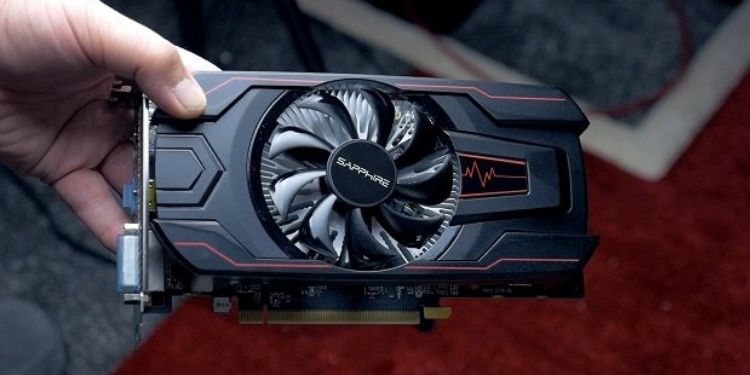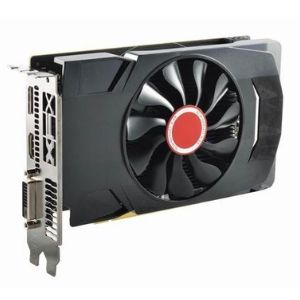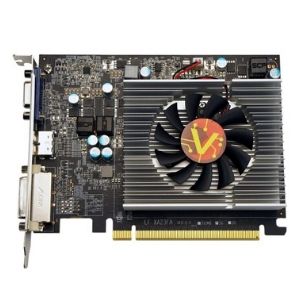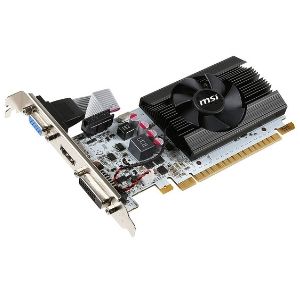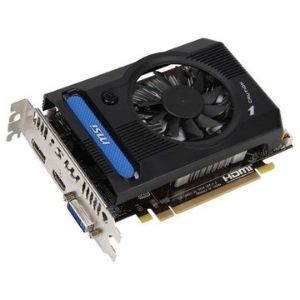Nothing’s going to stop gamers from building a gaming machine, even if they only have $300 to their name and no electricity! If you find yourself in a similar situation, except maybe with access to electricity, then that’s probably why you’re looking for the best graphics card under $100.
We’ve rounded up all the graphics in this price range and did an intensive comparison to see which among these really are worth spending. You can also check out our overall budget graphics card guide to find the best GPU in the $100 – $300 price range.
Best Under $100
XFX RX-560D4SFG5 Radeon RX 560
- Frame Buffer: 2GB GDDR5
- Memory Clock: 7000 MHz
- Base (Boost) Clock: 1175 MHz (1216 MHz)
- Display Output: 1x DL-DVI-D, 1x HDMI 2.0b, 1x DisplayPort 1.4
- Memory Interface: 128-bit
- TDP: 90W
- Size(L x W x H): 8.31 x 1.57 x 4.41 inches
Best Low Profile
EVGA GeForce GT 1030 SC 2GB GDDR5 Low Profile
- Frame Buffer: 2GB GDDR5
- Memory Clock: 6000 MHz
- Base (Boost) Clock: 1290 MHz (1544 MHz)
- Display Output: HDMI, DVI-D
- Memory Interface: 64-bit
- TDP: 30W
- Size (L x W x H): 5.7 x 1.5 x 2.71 inches
Cheap with Good Performance
VisionTek Radeon Radeon R7 250
- Frame Buffer: 1GB GDDR5
- Memory Clock: 4600 MHz
- Base (Boost) Clock: 1000 MHz (1050 MHz)
- Display Output: DisplayPort, HDMI, DVI-D
- Memory Interface: 128-bit
- TDP: 70W
- Size (L x W x H): 10 x 7 x 1.5 inches
GDDR5 Graphics Card Under $100
MSI GeForce GT 730 Kepler
- Frame Buffer: 2GB GDDR5
- Memory Clock: 5000 MHz
- Base (Boost) Clock: 700 MHz (902 MHz)
- Display Output: VGA, DVI-D, HDMI
- Memory Interface: 128-bit
- TDP: 65W
- Size (L x W x H): 9.5 x 6.6 x 2.1 inches
Best Bang for Your Buck GPU
MSI AMD Radeon R7 240
- Frame Buffer: 2GB GDDR3
- Memory Clock: 1800 MHz
- Base (Boost) Clock: 730 MHz (780 MHz)
- Display Output: DVI-D, HDMI, VGA
- Memory Interface: 64-bit
- TDP: 35W
- Size (L x W x H): 5.7 x 2.7 x 0.9 inches
Table of Contents
1. XFX RX-560D4SFG5 Radeon RX 560
Best Gaming Graphics Card Under $100
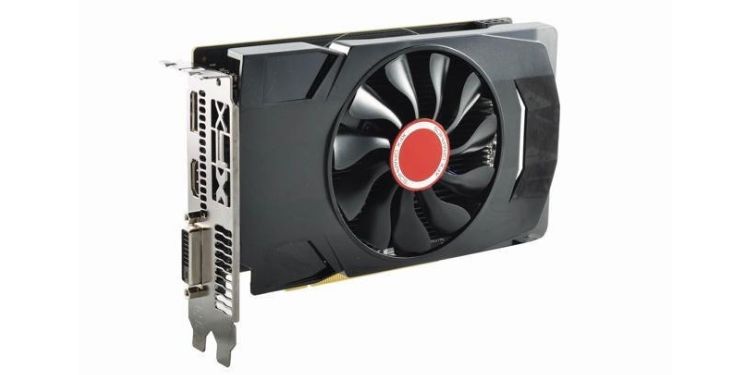
- Frame Buffer: 2GB GDDR5
- Memory Clock: 7000 MHz
- Base (Boost) Clock: 1175 MHz (1216 MHz)
- Display Output: 1x DL-DVI-D, 1x HDMI 2.0b, 1x DisplayPort 1.4
- Memory Interface: 128-bit
- TDP: 90W
- Size (L x W x H): 8.31 x 1.57 x 4.41 inches
- Can handle 1080p graphics performance
- Quality price to performance
- Requires a 6-pin PCIe connector
If you’re looking to invest in the best GPU under $100, nothing can beat the XFX RX-560D4SFG5 Radeon RX 560. It’s got enough power to run games at 1080p at medium to high settings. Although there are downsides you need to take note of.
While this can handle 1080p fairly well, you’ll have to tone the graphics settings down if you want to stay within 60 FPS. For the most part, though, you get over 40 FPS in most titles at 1080p on medium settings.
The card can also support up to 3 displays: 1 DVI-D, 1 HDMI 2.0, and 1 DisplayPort. So if you wish to take advantage of AMD’s Eyefinity technology for an immersive 3-monitor gaming experience, this is your best bet if you only have $100 to spare for a GPU.
It also has 2 fans so it shouldn’t be as loud as some of the graphics cards with only 1 fan. On a similar note, you also have slightly better performance since it has a small factory overclock. Of course, because of this, you’ll need to make sure your power supply has a 6-pin PCIe connection for this card.
It is worth noting that this card pushed right up against our $100 limit. Why? Well, the extra $10-$30 can make a really big difference at this price range; more so than any other price range (for obvious reasons).
2. EVGA GeForce GT 1030 SC 2GB GDDR5 Low Profile
Best Low Profile Graphics Card
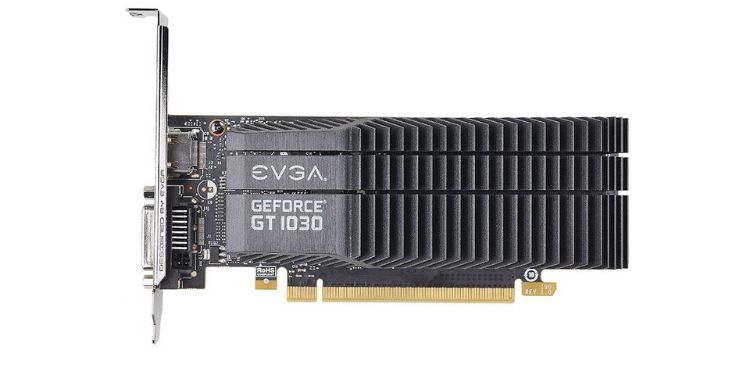
- Frame Buffer: 2GB GDDR5
- Memory Clock: 6000 MHz
- Base (Boost) Clock: 1290 MHz (1544 MHz)
- Display Output: HDMI, DVI-D
- Memory Interface: 64-bit
- TDP: 30W
- Size (L x W x H): 5.7 x 1.5 x 2.71 inches
- Doesn’t need a power connector
- Compact and silent
- Isn’t as powerful as the RX 560
Going with our top pick is a no-brainer if you simply want the best graphics card under $100. But if your power supply does not come with a 6-pin PCIe connector, which is likely the case if you’re running a low-end computer system, the EVGA GeForce GT 1030 SC 2GB GDDR5 Low Profile is the perfect alternative.
Of all the GT-series graphics card, this is the best video card under $100 that does not need a 6-pin PCIe power connector. In fact, it could run a handful of games such as PUBG, Ghost Recon: Wildlands, The Witcher 3, GTA V, and more, at 1080p on very low settings-- definitely not the best graphics but it can run these games fine at between 40-60 FPS, depending on the game.
Unlike the RX 560 above, this doesn’t need a 6-pin PCIe connector to power it up. After you secure the card in place, you’re good to go. As you’d expect, this also means that its power consumption is also lower than the RX 560.
If you’re observant, then you’ve already noticed this has a faster base and boost clock speed than the RX 560; however, because this runs on a 64-bit memory interface rather than the RX 560’s 128-bit memory interface, there is a somewhat noticeable performance gap. Though this may be a little loud when under load as it only has 1 fan it shouldn’t be a distraction.
And if 1 monitor isn’t enough, you can add a second one-- but that’s it. Just make sure that the monitor has either HDMI or DVI-D ports because this card can only output to one of each type of display.
3. VisionTek Radeon Radeon R7 250
A Good Cheap Graphics Card that Offers Good Performance
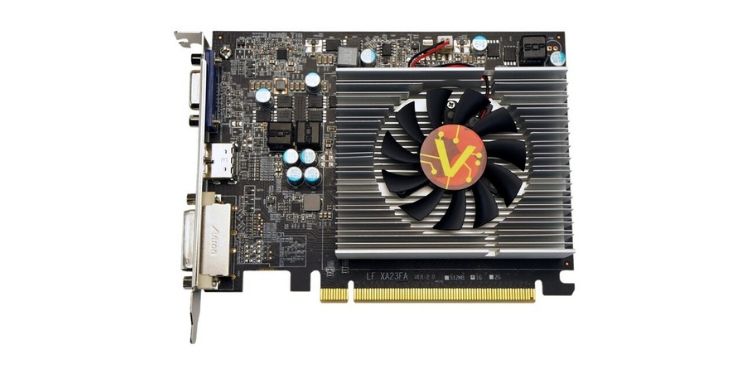
- Frame Buffer: 1GB GDDR5
- Memory Clock: 4600 MHz
- Base (Boost) Clock: 1000 MHz (1050 MHz)
- Display Output: DisplayPort, HDMI, DVI-D
- Memory Interface: 128-bit
- TDP: 70W
- Size (L x W x H): 10 x 7 x 1.5 inches
- Doesn’t need a power connector
- Compact
- Only has 1GB GDDR5
Just like the GT 1030 graphics card, the VisionTek Radeon Radeon R7 250 does not require a 6-pin PCIe power connector to work. After you install this it’s ready to go. But unlike the GT 1030, this comes with 3 display outputs: VGA, HDMI, and DVI-D. So if you think 2 monitors aren’t enough, this will most certainly be for you.
Just keep in mind that this may not be as powerful as the GT 1030 above but it should be enough for light gaming. And by light gaming I mean indie and eSports titles like CS:GO, Fortnite, League of Legends, and DOTA 2.
This isn’t the card for you if you wish to play games at 1080p, though. If you’re fine playing some old games at 900p or 720p, then this might be for you. Lowering the resolution down to either 900p or 720p and setting the graphics settings down to high or medium from ultra will net you an average of 40+ FPS, which should be totally playable for most non-competitive titles (most console games stick around 30 FPS).
Compared to the GT 1030, this is smaller in size and only has 1GB of GDDR5 memory, so it isn’t going to consume as much power.
4. MSI GeForce GT 730 Kepler
A GDDR5 Graphics Card Under $100 that can run eSports titles
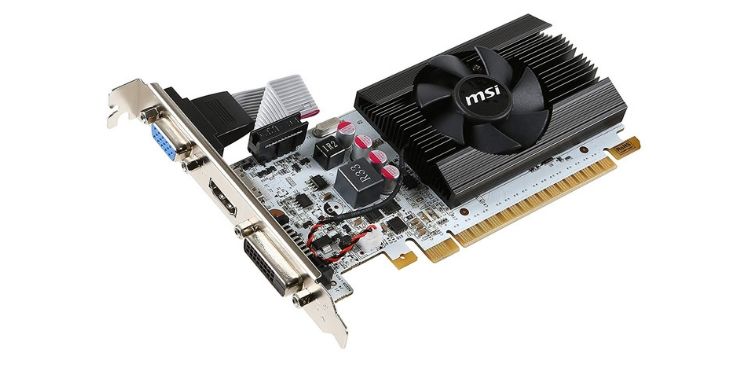
- Frame Buffer: 2GB GDDR5
- Memory Clock: 5000 MHz
- Base (Boost) Clock: 700 MHz (902 MHz)
- Display Output: VGA, DVI-D, HDMI
- Memory Interface: 128-bit
- TDP: 65W
- Size (L x W x H): 9.5 x 6.6 x 2.1 inches
- Very affordable
- Can output to up to 3 displays
- Compact
- Not for AAA gaming
The MSI GeForce GT 730 Kepler is a highly recommended graphics card if you’re looking for a really cheap alternative. Whether it’s 900p or 720p, you won’t go wrong with this card.
It only cost about 70% of our limit, but it can still run eSports titles and other light games fairly well. Specifically, games like Skyrim, GTA V, CS:GO, League of Legends, DOTA 2, and Rocket League will net you an average of 30 FPS at 720p or 900p on low settings, depending on the game. While this is far from the best PC gaming can provide, still having access to mods for games like Skyrim still sets it apart from its console cousins.
If you’re a casual gamer looking to upgrade your old system, this card should be able to handle it well. It supports the legacy VGA output, so it should go along with your old system just fine. But if your monitor only supports DisplayPort, then you’ll need a display converter, or a new display (although that would largely defeat the purpose of a budget GPU).
Like the GT 1030 above, you don’t need a 6-pin PCIe connector to power this up. And similar to the R7 250, it can handle up to 3 displays at once-- great if you’re looking to maximize productivity.
5. MSI AMD Radeon R7 240
Best Bang for Your Buck GPU
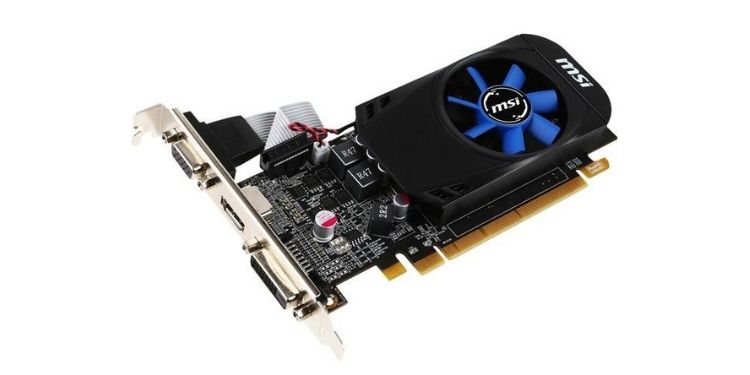
- Frame Buffer: 2GB GDDR3
- Memory Clock: 1800 MHz
- Base (Boost) Clock: 730 MHz (780 MHz)
- Display Output: DVI-D, HDMI, VGA
- Memory Interface: 64-bit
- TDP: 35W
- Size (L x W x H): 5.7 x 2.7 x 0.9 inches
- No external power needed
- Very compact design
- Low-power consumption card
- Uses GDDR3 technology
Our roundup won’t be complete without our budget pick (wait, aren’t these all sort of budget picks?). For this roundup, we have the MSI AMD Radeon R7 240. This is a card that’s perfect for 900p gaming.
It’s about half as cheap as the top pick, but it can still handle some of the most popular games of 2018 and 2019 like Fortnite, PUBG Lite, CS:GO, and Fifa 2019 at 1080p while on the lowest preset. Turning the resolution down to 900p will give you an even more stable gameplay experience.
It won’t give you stellar graphics, but 30 FPS is perfectly playable for casual gaming. Other eSports titles like League of Legends, DOTA 2, and Overwatch also run perfectly with a mix of settings at 768p resolution. Setting everything to the lowest setting at 720p will net you over 60 FPS in most old titles but definitely no modern AAA titles for this one.
Much like most of the cards on this list, this does not require a 6-pin PCIe connector; similarly, it can display to a maximum of 3 displays: DVI-D, HDMI, VGA. Now, if you’re looking for a really, really, cheap card to maximize your productivity, this will surely be the card for you. Just make sure your monitor supports these ports.
Overall, it’s a small card that will fit in most setups. So regardless of the size of your rig, this should fit in just fine.
How to Pick the Best Graphics Card Under $100 for Your Needs
To sum up, cards in this price range may not give you outstanding performance at 1080p but should give you decent performance at 900p or 720p. Of course, how it performs depends heavily on the type of game you’re playing, the specific graphics settings you’re using, and, perhaps most importantly, the specific card you actually end up buying. You can also check out our best graphics cards under $200 in our guide here.
Even though we laid out our top picks, you might still have a lot of questions. So, before you “cash out and regret later”, here are some of the most important things you should keep in mind when shopping for a graphics card under $100.
Size
Graphics cards in this price range fit perfectly inside most cases. But if you’re planning to build a really small computer, go for the smallest ones we have on the list. Specifically, either the EVGA GeForce GT 1030 or the MSI AMD Radeon R7 240. These cards are small enough to fit inside small cases, even a mini-ITX motherboard.
Cooling
Graphics cards have varying cooling solutions. Needless to say, more fans are more efficient at keeping the temperatures down and, since they are spreading the work out evenly, they don’t work as hard. In other words, they are quieter… and more expensive.
Well, at least usually. It depends on the capability of the card, specifically its TDP. For reference, TDP is the max amount of power the card needs to keep the temps below the maximum temperature.
On the flip side, cards with only 1 fan are louder since they need more power to keep the temperature down. And even with the fan curve adjusted, it still isn’t going to be as efficient as cards with 2 or 3 fans.
Ideally, you’ll want to avoid graphics cards with one fan. But considering this is a roundup of graphics cards under $100, it’s unlikely you can grab a card with 3 fans without sacrificing any performance.
Power Requirements
Newer cards are designed to consume less power than older cards. However, this doesn’t change the fact that higher-end cards consume more power than mid-end cards.
Regardless, the graphics card must be paired with a reliable power supply. Otherwise, you’ll end up cashing out today and regretting later. To know how much wattage your card needs, check the card’s TDP (thermal design power), which can easily be found by heading over to the card’s website.
There are online resources like PCPARTPICKER that lets you check both compatibility and theoretical power consumption. Though it’s not 100% accurate, it’s still worth checking.
Performance
Take a look at the specs of the card. It’s a rule of thumb that you do your research prior to buying any computer component– not just graphics cards. In the case of graphics cards, you’ll want to check the clock speed, boost speed, the amount of– and type of– VRAM it has, and benchmark results online.
Ideally, you’ll want to choose according to what processor you have to eliminate bottlenecks. Bottlenecking occurs when you pair an old processor with a newer, higher-end graphics card (or vice-versa). However, if you’re planning to upgrade to a more powerful processor soon, buying the most powerful graphics card you can get your hands on in this price range is a no brainer.
I/O Connectors
Graphics cards have varying I/O ports; some support legacy ports, like VGA, but some don’t. As such, it’s vital you check the I/O ports at the back of the monitor first to make sure you’re getting a card that supports it.
Most of the graphics cards these days support DP and HDMI ports so it’s important that you opt for a monitor that supports these display inputs if you still haven’t got one. Although there are converter ports for those of you who already own a monitor but don’t have these inputs.
And that’s that, the best graphics cards under $100 from our own in-house testing. If your curious to know what the overall best graphics card is you can check out our buyer guide here.

